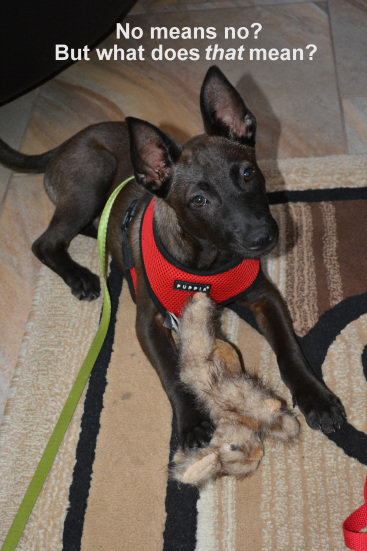
A friend and I were recently walking out my front door while my dog, Kona, was close at our heels. She turned around and told him “no”. I told her that word means nothing to him and asked him to “back up” instead (a behavior he knows well). This sparked the conversation of “you’re a dog trainer, how does your dog not understand the word ‘no’?” My simple answer is “because he’s never been taught what that means”.
Dogs are not born with an inherent knowledge of the human language or culture. Can they learn a word by the context in which it is delivered? You bet! But it’s up to us to attach some useful information to that word to help them navigate our world where we expect them to live within our expectations. If I yelled “no!” at Kona in a stern tone would he immediately stop what he was doing? He might stop in that instant but what is he supposed to do after that? It’s not really fair for me to tell him to stop doing something without providing any follow up information.
How many of us have had this conversation with our significant other:
You: What do you want for dinner?
SO: I don’t know. What do you want?
You: How about Chinese food?
SO: No.
You: Ok, how about Mexican?
SO: No.
You: Then why don’t YOU pick something!
It’s frustrating when someone tells you “no” without providing an alternative isn’t it? Without any additional information you don’t know what to do next. Is he/she saying “no” to Chinese food because they aren’t hungry or because they don’t like Chinese? Did they just eat Mexican for lunch and don’t want it again for dinner? WHAT DOES IT MEAN?? Without any additional information you have no idea what to do next! It’s the same for our dogs. “No” doesn’t hold any weight unless you’ve associated a meaning to it for a specific behavior.
It is very common for us humans to think “no” can be just a blanket term for “stop what you’re doing this instant” (and don’t do it again) but in reality, most dogs have no idea what that means and are just responding to the tone of our voices. I have taught my dogs many useful behaviors that are all on cue, meaning they have a word or signal attached to them. I have taught them to problem solve and to respond to my cues. I taught them all of this through positive reinforcement training based on mutual trust and respect.
I have never had the need to teach my dogs “no” because it has no use in our relationship. Do my dogs do things on occasion that I might not like? Of course! But that’s where the other behaviors they know come into play. I will discuss some alternate behaviors you can teach to prevent unwanted behaviors in a follow up post. In the meantime, if anyone has a solution to the ongoing “what do you want for dinner?” debate with your SO, please share in the comments!

